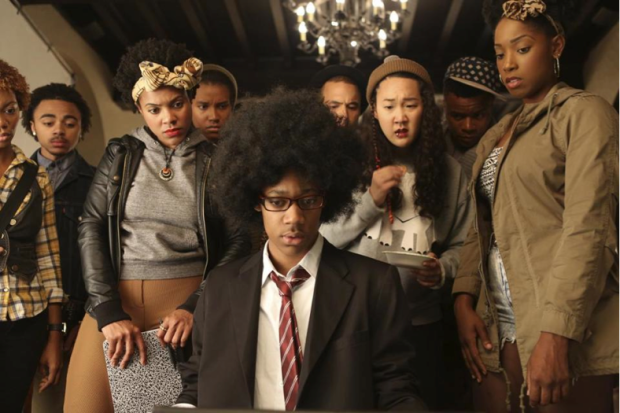As an organizer and educator working with students of color, when Dear White People came out I had to watch it. From the various trailers, and the tagline of “being a Black face in a white place,” I was excited to see a film center the often invisible experiences of Black college students at a predominantly white institution. Overall, I enjoyed watching the movie. The trials and tribulations of Black students, ranging from the trivial to the dangerously violent, rang painfully true. I could relate to the struggle of a handful of students of color to respond: the confused passion of Sam, Lionel’s perpetual search for community, the idealistic and pragmatic activist embodied in Reggie.
Despite its redeeming qualities, I left the theater feeling deeply unsettled by the film’s portrayal of Asian Americans. [Spoiler alert.] Towards the end of the film, Lionel informs the Black Student Union that there is a party being organized on campus based on stereotypes of African-American/Black students. In short, white students are required to perpetuate blackface in all of its forms at this event. After Lionel alerts the BSU, Sungmi, the one Asian American character in the film who has a speaking role, encourages BSU members to join with the Asian American and Latin@ student organizations on campus to charge into the party and shut it down.
In theory, this is great – students of color in the broadest sense should all have a vested interest in protesting campus parties based in dangerous stereotypes. However, in Dear White People‘s portrayal, Asian Americans and Latin@ students are literally rendered voiceless.(1) The viewers don’t see their decision to join BSU members in shutting the party down, and simply see angry Asian faces, and a single Latino face, confronting white partygoers. These angry Asian faces have no names, no history, no context—and literally no voice. Is there a more typical Asian American stereotype than an Asian without a voice?

Scene from “Dear White People.”
Despite Naomi Ko (the actress who plays Sungmi) and other voices celebrating the progressive portrayal of Asian Americans in solidarity with Black folks, I’m not convinced. There is a more nuanced racial politic at play here. Asian Americans often have the racial privilege of being seen as a ‘model minority,’ a stereotype that can be used as a shield against the anti-Blackness that undergirds the most brutal forms of American racism. Asian Americans need to do internal work to build a racial awareness that locates and places ourselves on the racial hierarchy of the U.S. If you aren’t able to speak to the long and arduous process of building solidarity across these racial differences – don’t show a half-baked version. The dark side to the Model Minority Myth is a portrayal of Asian Americans as timid and voiceless, hard-working minions without a mind of our own. If you can’t portray Asian Americans as multi-faceted, don’t portray us at all. Instead, show the equally powerful story of Black students standing up for themselves, and pushing back against a party with a centuries-long history of racism.
If you want to prioritize a demonstration of cross-racial solidarity, including Asian Americans, take the time to build it, on or off screen. It’s not enough to demonstrate Asian Americans standing in solidarity with Black folks; you have to show the internal and cross-community work that leads to that coalition. Solidarity and coalitional politics aren’t achieved overnight (or simply through “having better snacks”). It’s a long, drawn-out, painful process, a constant assessing and re-assessing of our shared struggles, our radical possibilities, and our contradictions. Without that process shown, or even gestured towards, on screen, Asian Americans are reduced once again to racial props, ready to step in when necessary but without names or voices, issues or agendas. If we don’t grapple with the hard questions of how we truly shape our issues as interconnected, and how we arrive at the always tenuous conclusion of solidarity, we risk losing the potential to truly build—while simultaneously reifying age-old Asian American stereotypes.
***********
(1) The role of Latin@s in this film, while in some ways similar to that of Asian Americans, needs another analysis – and one that I will not attempt to undertake here. (I do look forward to reading it, though!)
First of all I want to say terrific blog! I had a quick question which I’d like to ask if you
don’t mind. I was curious to know how you center yourself and clear your thoughts before writing.
I have had a tough time clearing my mind in getting my ideas out there.
I do take pleasure in writing but it just seems like the first 10 to 15 minutes are lost simply just
trying to figure out how to begin. Any ideas or hints?
Appreciate it!
Hi archaic, thanks for reading & commenting!
I often have the feeling that thoughts are about to spill out of my mind – and ideally, that’s when I write. Usually at night, when I’ve told myself that I’m not going to be getting any more ‘tasks’ done, and usually in silence. I’m also not a very frequent writer, so I usually wait until the writing itself feels urgent.
Greate article. Keep writing such kind of information on your blog.
Im really impressed by it.
Hello there, You’ve performed a great job.
I will certainly digg it and individually suggest to my friends.
I’m sure they’ll be benefited from this web site.